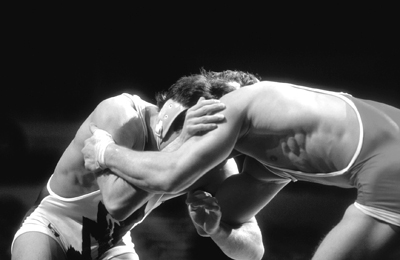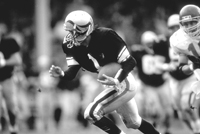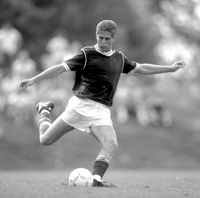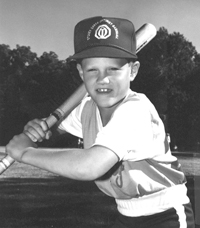
Features
Practice
Technique
Sports Massage
Sports Massage is as old as massage itself. With literature that dates back to the early Olympics and even pre-dated by Chinese text referring to the Shaolin Temples, active people have sought remedy for the physical effects of exercise and sporting activities for many years.
September 23, 2009 By Wayne Baiton
Sports Massage is as old as massage itself. With literature that dates
back to the early Olympics and even pre-dated by Chinese text referring
to the Shaolin Temples, active people have sought remedy for the
physical effects of exercise and sporting activities for many years.
Sports Massage has been passed down through the centuries from teacher
to student, not much differently than sporting skills themselves.

|
|
|
It is quite remarkable that, in our quickly evolving technological age,
something as simple as this athletically inclined form of manual
medicine, has survived relatively unchanged when compared with many
other forms of patient care.
In the large picture, physical contact by caring hands and the
manipulation of the musculoskeletal components of the body have
remained very similar over a very long time. Only in the last few
decades have numerous authors and practitioners laid claim to certain
‘techniques’ and ‘styles.’
When most people hear of the phrase Sports Massage they envision hard
working therapists volunteering their services at an athletic event,
working on the athletes, either before or after the event. Perhaps you
can relate with this brief description, and have either seen or been
that person yourself. This form of treatment is more accurately termed
Pre- and Post-Event Sports Massage. It is a significant part of a
larger picture.
Sports Massage may be identified and approached according to the
various settings in which it is performed and the objectives of the
different applications.
Although specific details may vary, certain treatment objectives and goals remain consistent.
I offer one such description or definition of the various Sports Massage treatment orientations.
These orientations may be listed and summarized as:
1. Pre-Event Sports Massage
2. Inter-Competition Sports Massage
3. Post-Event Sports Massage
4. Maintenance Sports Massage
5. Sports Massage Therapy
1. Massage performed prior to an athletic event or some form of
physical activity (Pre-event); 2. Massage performed during the
competition in between activities or in substitution shifts
(Inter-competition); 3. Massage after the completion of the activity
(Post-event); 4. the regular treatment performed to the athlete on a
weekly or bi-weekly basis away from the training field or competitive
environment (Maintenance), and finally; (5) the treatment applied in
the situation of an injury or performance limiting condition (Sports
Massage Therapy).

|
|
|
The primary differences of each type are generally classified into
timing of application, technique and treatment intent or goals.
Often the Sports Massage Therapist will find the most challenging
aspect of working with athletes is attempting to develop a compatible
schedule of treatment that meets the needs of the athlete and the
objectives of the treatment simultaneously. Often compromises must be
made.
While adjusting to realistic expectations for treatment outcomes and
benefits, the safety of the athlete (patient) should never be subjected
to compromise.
The following provides a basic description of the various Sports Massage orientations.
Pre-Event Sports Massage
– Pre-Event Sports Massage is applied before the athlete’s event in
conjunction with their warm-up procedure. Optimally, it should be
performed between 15 to 45 minutes before the beginning of activity and
the total treatment time is limited to 15 or 20 minutes. The techniques
are performed without oil, therefore may be performed over clothing.
The hand movements are brisk and stimulating.
This type of massage is not corrective in nature, but preparatory. The
intent is focussed on increasing blood supply to the muscle/tendon
complex and stimulating the neuro-muscular system for the upcoming
activity.
Pre-Event Sports Massage is designed to compliment an athlete’s warm-up procedures, not replace them.
Inter-Competitive Sports Massage
– Inter-Competitive Sports Massage is an adaptation of Pre-event
application. The techniques are a passive method to maintain blood
circulation and to re-distribute the generated metabolic bi-products of
the physical activity. The therapist may not have the convenience of a
massage table and may have to adapt to the setting (chair, ground).
Post-Event Sports Massage
– As the name implies, Post-Event Sports Massage is performed usually
within two hours after the athlete’s activity has ended. Optimal
application would be 15 minutes after such an event, however, positive
effects may be experienced up to 10 hours after the event. The
techniques are applied directly to the skin using an oil or cream
lubricant. Post-Event Sports massage should NOT hurt! Tissue drainage,
fibre separation and soothing of the fatigued tissue through increased
para-sympathetic output are the primary intent.

|
|
|
Maintenance Sports Massage
– Perhaps the most valuable application of massage concerning athletes
is the Maintenance Sports Massage (M/S/M). This orientation is
performed on regular intervals within the training program.
Russian research has determined that regular M/S/M significantly
reduces recovery time, allowing increases in frequency of intense
training periods, thus providing opportunity for the athlete to
maximize their performance potential over a given period of time. This
equates to more frequent training and faster skill acquiring. Top
international calibre athletes use daily treatments as an integral part
of their training regime. However, regularity of massage treatments is
more important than frequency and any regularly scheduled massage will
enhance the athlete’s training by controlling injury escalation and
eliminating training staleness.
The scope of massage techniques applied in M/S/M is wide and will vary
from athlete to athlete, sport to sport and condition to condition.
Another important aspect of M/S/M is familiarization of the athlete by
the therapist. The massage therapist can then adapt massage techniques
to tailor an effective personal treatment for each athlete.
Sports Massage Therapy
– Sports Massage Therapy or treatment focussed to the specific injuries
of the athlete require closer to typical methods of medical or
orthopaedic based assessment and treatment protocols. The comprehensive
nature of therapeutic treatment and the rehabilitation of physical
injuries require timeframes and patient compliability seldom found in
the training schedule and competitive environment of most athletes.
Even recreational athletes have difficulty in finding the necessary
time to rest an injury and allow full recovery.
It is sometimes only the athlete who suffers a substantial injury
(which completely prohibits involvement in their activity) that can
fully rehabilitate an injury.
While it is catastrophic to the athlete, it may mean being able to
return to the activity in a better condition than suffering though a
performance limiting chronic injury for several months or even seasons
of activity.
Pre- and Post-Event Sports Massage is by far the most noticed and
recognizable arena for the Sports Massage Therapist to promote
themselves and the field. Being able to educate the people involved
goes a long way
in promotion of one’s skills. To this end, the following are excerpts
from the Site Management and Athlete Education sections of WCRMT Sports
Massage Therapy course.
Athlete Education & Site Management
The Sports Massage Therapist will find it quite important and
beneficial, to contact the individual, team, coach, trainer, team
physician, and parents, prior to event time to ensure they are all
familiar with what the role of “event massage” is in the athletic
scenario. This also allows the Sports Massage Therapist to deliver an
understanding of what the event massage is capable of, and what its
limitations are.

|
|
|
This orientation will assist those concerned about how the event
massage will be administered and how the athletes should access the
service.
It must be made known that the Pre- and Post-Event massage scenarios
are not the places to send athletes with specific conditions to be
treated. It also should not be used by the event-practitioner to
attempt to normalize specific problems at such a short time before the
activity or event.
This can be compared to the coach attempting to make major alterations
to the technique of a precision athlete minutes before the event takes
place. Last-minute biomechanical alterations resulting from a
well-intentioned Sports Massage Therapist can have catastrophic effects
on the athlete’s performance, potentially resulting in serious injury.
The clinical situation and the methods adhered to in Sports Massage
Maintenance and Therapy is the proper environment to address injury.
In both Pre- and Post-Event, time is an important issue. Pre- and
Post-Event massage is usually delivered on a tight, formatted schedule.
This type of treatment is designed to treat as many people before and
after the competition as possible. This set-up provides the therapist
with valuable exposure to a number of athletes.
A strong familiarization with the mechanism of injury, process of
injury repair and stages of healing are mandatory to ensure the
therapist can recognize the signs and symptoms of acute injury, chronic
injury and shock in order to provide not just effective but safe
treatment.
Many injuries, however minor, can be made worse if the Massage
Therapist is unable to recognize the presence of injury and fails to
administer appropriate acute injury management. Post-Event Sports
Massage is contraindicated in the presence of acute musculoskeletal
injury, and only a well-trained and experienced therapist is able to
adapt treatment protocols to remain safe and effective.
Although the event site is not the forum to be treating any acute
injuries, the massage site may see a fair number of injured people
seeking aid. This is especially so in the case where there is no other
medical related personnel on the event site. For this reason, it is a
good precautionary measure to have basic first aid training and perhaps
a supply of ice on hand for situations where massage of any type would
be contraindicated.
The Sports Event Massage site should be accessible. In some situations,
the therapist is given some ability to choose the site where the
massage is to be administered.
When this opportunity presents itself, be sure to locate the site where the maximum number of people will
see the location.
Some modesty considerations are in order for Post-Event massage
application, but there are draping techniques to provide an acceptable
amount of privacy and still achieve substantial site exposure. Often
you will find event sports massage being administered on the in-field
of a track event or pool-side at a swim meet.
The next factor to be considered is the number of working tables at the
site. Due to the intensity of the treatment application and the tight
time schedules, the therapist may want to consider having a substitute
therapist or two. These individuals become invaluable when it comes to
restroom breaks or just providing a rest break for therapists booking
back to back treatments over a long period of time.
Every therapist will develop a working capacity. The amount of
treatment a therapist can provide will vary depending upon their
personal strength and muscular endurance.
Novice therapists should consider short two-hour time shifts to start
in order to find their workload capacity. If the massage at the events
is too laborious, the motivation to continue will begin to decline.
Event organizers and therapists should consider that the event will
undoubtedly be held again, and the volunteer sports therapists who have
been overworked may not want to participate again.
Massage therapy is more successful when it can be provided in an upbeat and positive environment.
At events involving a large number of participants, the Sports Massage
site should include a registration table. At this table there should be
people familiar with the event massage system so that accurate
information is communicated. This would be a good position for the
substitute therapists as they are familiar with the process and
timeframe instructions.
A sign-up sheet eliminates lineups and allows athletes to conduct a
proper warm-up or cool-down procedure. This allows the event massage to
compliment the performance of the athlete without disrupting the
athlete’s preparation or post activity routine. Completing and signing
waiver forms should be part of the sign-up procedure. Under-age
athletes will be required to have their forms signed by their parents
or acting authorized guardian (coach).
Linen may be required in varying amounts to provide an acceptable
degree of hygiene. The therapist at the event will quickly realize if
the feasibility of providing a clinical degree of inter-patient hygiene
is seriously compromised.
During most Post-Event massage and some Pre-Event massage, the
therapist will be working with direct skin contact and perspiration. An
antiseptic spray will assist in keeping the table and therapist’s hands
at an acceptable degree of sanitation.
In providing Event Sports Massage, the therapist has the responsibility
to provide effective and safe treatment. A strong knowledge in
pathology and some event experience will assist the therapist in
determining how much risk there is to the athlete and be able to
determine whether a hygiene clause should be included on the sports
massage waiver form.
Mud, sweat and blood may be evident due to events involving strenuous
outdoor activity. Event therapists will need to have latex gloves,
towels, buckets of water, or a nearby hose or shower to assist in the
process of treating these athletes.
In order for the massage therapist to safely and effectively treat
athletes, it is recommended that specific adjunctive knowledge be
acquired and sufficient field and clinical experience be gained.
Fundamental knowledge in exercise physiology, athletic training
principals, sports psychology, sports nutrition, surgical repair and
physical rehabilitation models of orthopaedic injury, sport
demographics, event management, on-site injury evaluation and taping
and supports knowledge are all aspects of a thorough Sports Massage
Therapy curriculum.
Sports-related specific knowledge and practical skills covering the
various types of sports massage technique are easily accessible through
various competent instructors and schools. Contact your local school or
the Canadian Sports Massage Therapy Association (CSMTA) for a
comprehensive study program and competent skill training.
This explanation of the various models of sports massage will help you,
the massage therapy student, alumni therapist and athlete, be aware of
what to expect in the various Sports Massage settings.
Wayne Baiton, RMT, and Ron Taylor, MD, have developed and
implemented a comprehensive sports therapy program for massage
therapists at the Western/Wellington College of Remedial Massage
Therapies since 1993. They also conduct weekend/seminars in Pre-and
Post-Event Sports Massage. They can be contacted at the Regina Campus
(306-757-2242) for more information.
Print this page